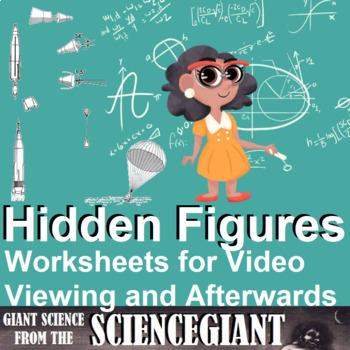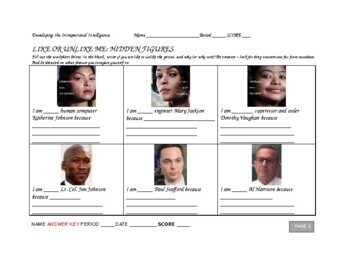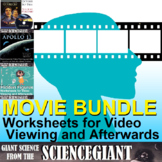Hidden Figures video viewing worksheets and after activities
- Word Document File
Also included in
- These resources can be used during a unit ( for example, on rocketry and the Space Race), as an emergency substitute activity at any point throughout the school year, or after the completion of state standardized testing (I've done all three). It consists of separate worksheets:Questions that studenPrice $3.85Original Price $5.50Save $1.65
Description
Hidden Figures tells the story of three female mathematicians in the early years of the space program. Their contributions to science, technology, engineering and mathematics led to some of NASA’s greatest successes.
Hidden Figures is the 2016 PG-rated adaptation of an incredible but true story of Katherine Johnson (Taraji Henson), Dorothy Vaughan (Octavia Spencer) and Mary Jackson (Janelle Monáe). The film is set in the early 1960s when workplaces were still segregated. Despite the social and political climate at the height of Jim Crow, these African-American women rose up and their research in 1962 helped John Glenn become the first American astronaut to orbit the Earth during the Friendship 7 mission.
This product can be used during a unit on rocketry and the Space Race, as an emergency substitute activity at any point throughout the school year, or after the completion of state standardized testing (I've done all three). It consists of four separate worksheets:
- 45 Questions that students should answer while watching the Hidden Figures. Questions are mostly lower order and focus on the film's plot. They are answered in chronological order of the film's plot for easy completion by students, and encourage student attentiveness.
- Like/Unlike worksheet for after viewing where students can compare and contrast themselves to the characters in the film, and write short answers which can detail their developing intra-personal Intelligence.
- Question Cards with Kagan cooperative learning structures fan-n-pick, or quiz-quiz-trade. These cards can be used to start the class conversation, or for comprehension checks in review. And they ensure every student is engaged. Quiz-quiz trade is a model of cooperative learning carried out by two students. Fan-n-pick is used for groups of four or more. Ss are paired, answer questions and exchange explanations using the cards until time has been determined. Directions for included, but there are no "right" answers.
- Lab activity provides learners with a template to create a rocket that can be launched from a soda straw during a hands-on activity. Ss are challenged to modify the design to see how the changes impact the rocket performance. Length (or angle or force) can be changed–one variable at a time–to see how the rocket improves compared to the control design.
This Strategic Instruction was classroom tested to help Ss with the following Florida Next Generation Sunshine State Standard Benchmarks: Students Will Be Able To (SWBAT/I Can)
- SC.8.N.4.1 Explain that science is one of the processes that can be used to inform decision making at the community, state, national, and international levels.
- SC.8.N.4.2 Explain how political, social, and economic concerns can affect science, and vice versa.
- SC.8.E.5.12 Summarize the effects of space exploration on the economy and culture of Florida.
- SC.912.N.2.5 Describe instances in which scientists' varied backgrounds, talents, interests, and goals influence the inferences and thus the explanations that they make about observations of natural phenomena and describe that competing interpretations (explanations) of scientists are a strength of science as they are a source of new, testable ideas that have the potential to add new evidence to support one or another of the explanations.
- SC.912.N.4.1 Explain how scientific knowledge and reasoning provide an empirically-based perspective to inform society's decision making.
- SC.912.N.4.2 Weigh the merits of alternative strategies for solving a specific societal problem by comparing a number of different costs and benefits, such as human, economic, and environmental.
- SC.912.E.5.7 Relate the history of and explain the justification for future space exploration and continuing technology development.
- SC.912.E.5.9 Analyze the broad effects of space exploration on the economy and culture of Florida.
Related Resource
- October Sky video viewing and after activities
- Apollo 13 video viewing and after activities
- Question Exploration and Lab: How Do Rockets Work?
- Question Exploration: How Are Latitude and Longitude Use for Landing Sites?
- Nibble Like a RABBit: Edible Model of a Moon to Mars Tool
- Mission Patch Plan: Design and Meaning for Moon to Mars
- If You Decide To Go To The Moon - ELA Enrichment Activities and Printables
#StayGiant and stay up on my new resources and STEM news. Look for the green ★ star near the top of any page within my store and click "FOLLOW". Or follow @TheScienceGiant Twitter. Stand on The Shoulders of Giants, and together we'll see further, inspire students, and enlighten inquisitive minds!






